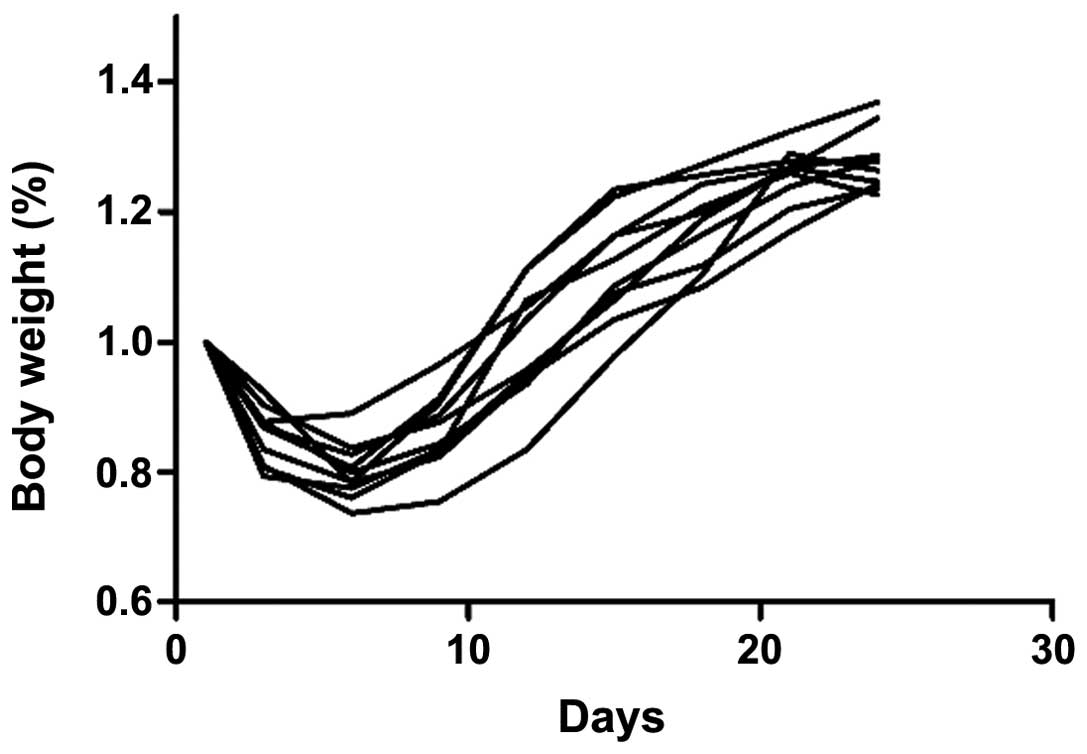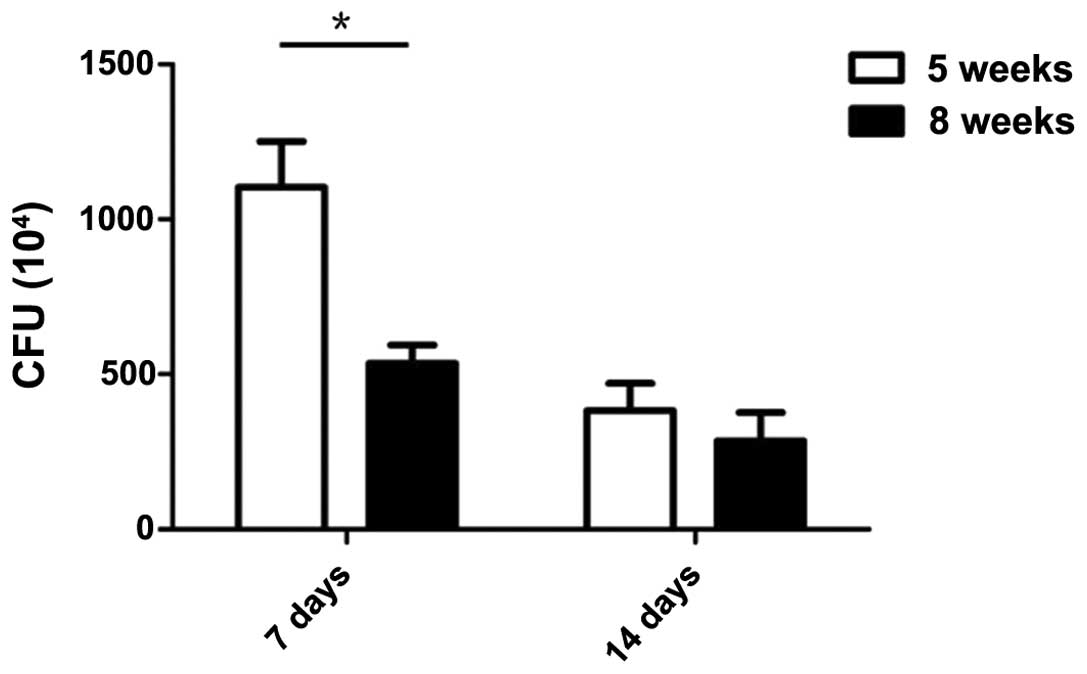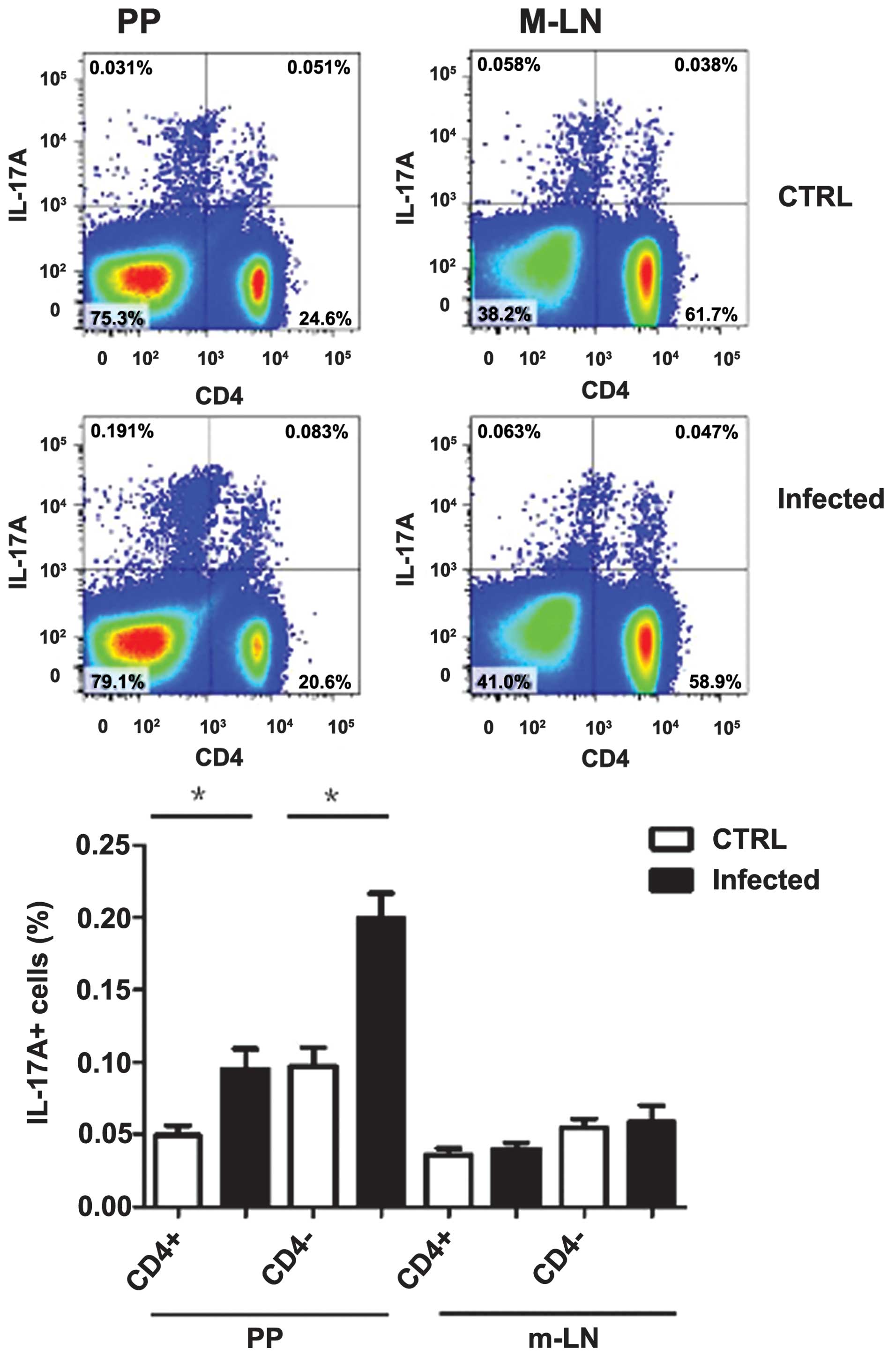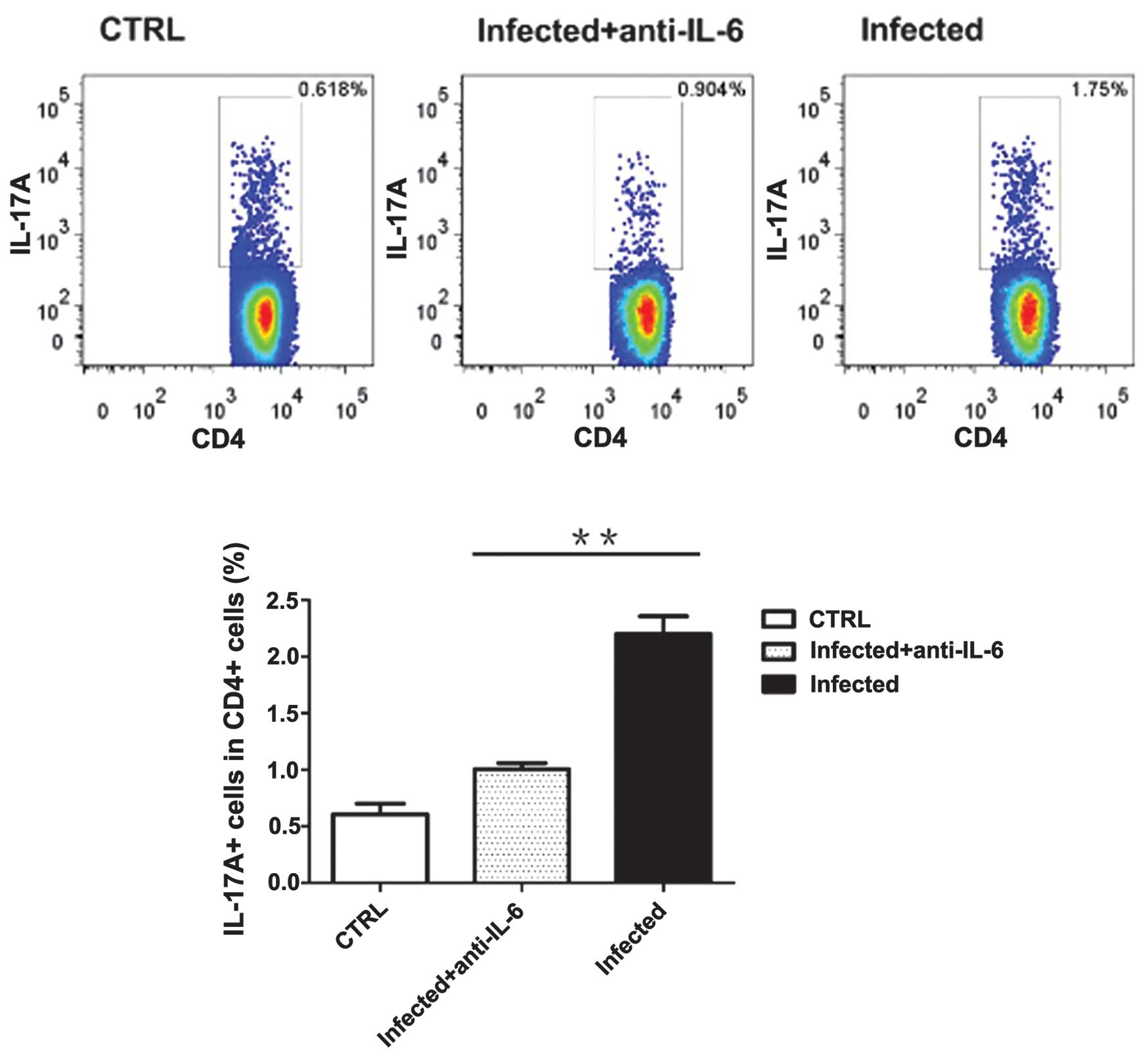Cytokine IL‑6 is required in Citrobacter rodentium infection‑induced intestinal Th17 responses and promotes IL‑22 expression in inflammatory bowel disease
- Authors:
- Published online on: January 14, 2014 https://doi.org/10.3892/mmr.2014.1898
- Pages: 831-836
Abstract
Introduction
Citrobacter rodentium (C. rodentium) is a predominantly mucosal enteric murine pathogen used in murine models of enteropathogenic Escherichia coli (E. Coli) and enterohemorrhagic E. coli infection in humans (1–3). C. rodentium infection in the colon surface results in epithelial hyperplasia and mucosal inflammation (4) and its colonization of the colon reaches its peak 7–10 days post inoculation (DPI) (5), followed by weight loss and diarrhea in association with crypt hyperplasia in mice and returns to normal by 14–25 DPI (6). It is also well established that C. rodentium infection induces significant mucosal infiltration of lymphocytes, macrophages, neutrophils and mast cells in the colon (7), goblet cell loss (2) and local and systemic inflammatory cytokines disorders (8,9).
Although innate cells that express Toll-like receptors, including CD11b+ myeloid cells, are known to play a major role in host defense against C. rodentium infection (9–11), adaptive immune cells are also involved in the eradication of C. rodentium infection (12). The roles of B and T cells with regard to protection against C. rodentium infection has been previously characterized (13,14). In the mice lacking antibodies production showed a higher susceptibility to C. rodentium infection compared with the wild-type mice. It is commonly accepted that T cells promote innate immune responses mostly by providing pro-inflammatory cytokines, however, in a previous study, T cells were observed to be involved in B cell dependent C. rodentium antigen specific antibody production and interacted with B cells directly (15). Pro-inflammatory cytokines, including interleukin (IL)-17A, IL-21 and IL-17A-induced IL-22 were shown to be crucial for the host defense against extracellular bacteria (16) and these cytokines were primarily secreted by Th17 subsets (17). In addition, it was previously shown that segmented filamentous bacteria (SFB), another microorganism that colonizes in the intestines, was sufficient to induce functional Th17 cells in the lamina propria (18). However in the model of C. rodentium infection, it was reported that IL-17A in this model was produced by innate cell subsets, including innate lymphoid tissue inducer cells (LTi cells), which was different from intestinal Th17 cells. Whether C. rodentium infection in mice increases CD4+ Th17 cell subset in the intestinal tissue remains unclear.
To identify the functions of C. rodentium infection in Th17 subset differentiation in the small intestine, C. rodentium was inoculated into 5-week-old wild-type B6 mice and the percentage of Th17 cell subsets in various tissues was observed. The results suggested that Th17 subset expression specifically increased in Peyer’s patches (PP) but did not alter in mesenteric draining lymph nodes. The mechanistic studies suggested that the inflammatory cytokine IL-6 was required in Th17 cell differentiation in PP as treatment with anti-IL-6 neutralizing antibodies reduced the Th17 subset percentage and aggravated the clinical manifestation of colitis. Furthermore, these intestinal Th17 cells were functional in innate responses to C. rodentium infection by inducing IL-22 production but not in promoting immunoglobulin A (IgA) production in the small intestine.
Materials and methods
Reagents and mice
C. rodentium strain DBS100 (catalog no. 51459) American Type Culture Collection (Manassas, VA, USA) was cultured in LB medium for 6 h at 37°C with agitation. Following 6 h, the bacterial density was assessed using absorbance at an optical density of 600 nm and confirmed by the plating of serial dilutions.
Five-week-old mice were orally inoculated with 1×109 colony forming units (cfu) of C. rodentium using a gavage needle. The body weights and the bacterial concentrations in the feces were assessed for 3 weeks subsequent to inoculation. PP and small intestine tissues were collected for quantitative polymerase chain reaction (PCR) and FACS analysis.
Bacterial quantification
Fresh fecal pellets were collected from the mice and dissolved in phosphate-buffered saline (PBS) at a concentration of 100 mg/ml. The bacterial colonies were quantified 24 h following the start of the culture.
Serum samples
Whole blood was collected from mice infected with C. rodentium. Serum samples were obtained by centrifugation at 16,000 × g for 10 min and stored at −20°C until use in subsequent experiments. Serum total IgA was detected using a mouse total IgA ELISA kit (Tiangen, Beijing, China).
Intracellular cytokine staining
The intracellular expression of IL-17-producing T cells was analyzed using a Cytofix/Cytoperm kit Plus (with GolgiStop; BD Biosciences, San Jose, CA, USA), according to the manufacturer’s instructions. In brief, lymphocytes obtained from spleens, MLNs or PP were incubated with 50 ng/ml PMA, 5 μM calcium ionophore A23187 (both from Sigma-Aldrich, St. Louis, MO, USA) and GolgiStop at 37°C for 4 h. Surface staining was performed with anti-CD4-PerCP/Cy5.5 (BioLegend, San Diego, CA, USA) for 20 min at 4°C, the cells were permeabilized with Cytofix/Cytoperm solution for 20 min at 4°C and intracellular cytokine staining was performed with anti-IL-17A-Alexa Fluor 647 (BD Biosciences).
Flow cytometry
The Abs used for flow cytometry included anti-CD4-PerCP/Cy5.5, anti-TCRb-FITC (BioLegend) and anti-IL-17A-PE (eBioscience, San Diego, CA, USA), according to the manufacturer’s instructions. Data were obtained using a FACS LSR II (BD Biosciences) and analyzed using FlowJo software (Tree Star, Inc., Ashland, OR, USA).
Quantitative PCR
Total RNA was extracted with TRIzol reagent (Invitrogen Life Technologies, Carlsbad, CA, USA) according to the manufacturer’s instructions. Reverse transcription was performed with a High Capacity cDNA Reverse Transcription kit (Applied Biosystems, Tokyo, Japan) according to the manufacturer’s instructions. Quantitative PCR was performed with SYBR-Green PCR Master Mix (Applied Biosystems) according to the manufacturer’s instructions. The reaction conditions consisted of 40 cycles of two-stage PCR consisting of denaturation at 95°C for 15 sec and annealing at 60°C for 1 min following an initial denaturation step of 95°C for 10 min. The primer sequences used were: mouse interferon-γ (IFN-γ), forward: 5′-TCAAGTGGCATAGATGTGGAAGAA-3′ and reverse: 5′-TGGCTCTGCAGGATTTTCATG-3′; IL-17A, forward: 5′-ATCAGGACGCGCAAACATG-3′ and reverse: 5′-TGATCGCTGCTGCCTTCAC-3′; and mouse β-actin, forward: 5′-AGAGGGAAATCGTGCGTGAC-3′ and reverse: 5′-CAATAGTGATGACCTGGCCGT-3′. To allow comparisons of mRNA expression levels, the real-time PCR data were analyzed with the ΔΔCt method and normalized to the amount of β-actin cDNA as an endogenous control.
Fecal IgA
Fresh fecal pellets were collected from the mice and dissolved in PBS at a concentration of 100 mg/ml. Fecal IgA was examined with a mouse IgA-detecting kit (Tiangen).
Statistical analysis
Data are expressed as mean ± SE and statistical significance was analyzed using the Student’s t-test. P<0.05 was considered to indicate a statistically significant difference.
Results
C. rodentium infection induces inflammatory bowel disease (IBD) in mice
C. rodentium infection induced IBD in mice is a commonly used animal model to study innate cell responses and inflammatory signaling in intestinal inflammation in vivo. To examine the importance of T cells in IBD caused by C. rodentium, wild-type female B6 mice of various ages were infected with C. rodentium at 4×109 cfu/mouse. A survival curve, body weight loss and clinical manifestation of colitis were monitored during a course of 3 weeks following infection and young mice (3 weeks) were observed to be highly susceptible to C. rodentium infection as they cannot survive colitis infection (Fig. 1). C. rodentium was capable of inducing IBD in the mice between 5 and 8 weeks old, however, the older mice (8 weeks) exhibited less susceptibility compared with the 5-week-old mice (Fig. 2), as they lost significantly less body weight (Fig. 3).
Considering that innate immune cells were immature in newborn mice and the newborn mice did not have sufficient amounts of IgA antibody secretion on the surface of the intestine, which was significant in the host against microbe infection (14), female mice of 5 weeks age were selected for the present study. The body weight continued to decrease in the first 10 days following C. rodentium infection and visible colonic inflammation, including diarrhea and loss of appetite was observed. Loss of appetite was observed in the first 1 week following C. rodentium infection. Bacterial counts in fecal pellets showed that the amount of C. rodentium reached the peak at day 7 and returned to normal 2 weeks following infection (Fig. 4). However, there was no significant difference observed between the male and female groups (data not shown).
C. rodentium infection increased the Th17 subset specifically in PP
The pro-inflammatory cytokine IL-17A is critical for host response to the invasion of the immune system by extracellular pathogens (19,21) by increasing chemokine production in various tissues to recruit innate cells, including monocytes and neutrophils to the site of local infection. In the model of C. rodentium infection, it was reported that C. rodentium-induced colitis triggers strong IL-17A secretion in the small intestine in mice (17). Recent studies suggested that IL-17A was primarily secreted by LTi cells and ‘innate’ Th17 cells (16,20). However, whether C. rodentium infection was capable of increasing the classic Th17 subset in vivo remains unclear.
To confirm intestinal Th17 differentiation in colitis, 5-week-old female B6 wild-type mice were infected with C. rodentium (4×109 cfu/mouse) or inactivated C. rodentium as the control group. Mice were sacrificed 7 days following infection and Th17 cells group were examined using intercellular staining of the cytokine IL-17A. IL-17A producing CD4+ T cells group were observed to increase in PP, but no significant change in mesenteric draining lymph nodes was observed. Notably, the IL-17-producing non-T cell-group (TCRb-CD4−) also increased in PP and did not change in the m-LN group (Fig. 5) and these innate cells produced increased IL-17A compared with CD4+ Th17 cells, which was consistent with a previous report (16). However, the innate cells cannot protect the host from C. rodentium infection, as it was observed that these mice lack T cells and with functional innate cells, including Rag1 deficient mice, exhibited a higher susceptibility to IBD compared with the wild-type mice. In addition, the mice with colitis also exhibited increased PP and shorter length of the small intestine when compared with the control group (data not shown).
IL-6 is required in intestinal Th17 differentiation in C. rodentium-induced colitis model
The IL-6 cytokine was required in Th17 differentiation and activation in vitro and in vivo. Early induction of IL-6 secretion was critical in the host response to enteric microbial infection. C. rodentium-infected female B6 wild-type mice were treated with anti-IL-6 neutralizing antibodies or control IgG to block IL-6 signaling 0 and 3 days following infection. These mice were sacrificed 7 days following infection and cells from PP were collected for intercellular cytokine analysis. The results suggest that treatment with anti-IL-6 neutralizing antibodies was capable of decreasing IL-17A-producing CD4+ T cells in PP (Fig. 6). However, the percentage of Th17 cells in PP remained higher than that in mice treated with inactivated C. rodentium. Similarly, anti-IL-6 neutralizing antibody-treated mice exhibited more severe clinical symptoms compared with the control IgG-treated group. However, results of the statistical analysis of clinical scores and length of the small intestine revealed no significant difference (data not shown).
IL-17A production in non-T cells was investigated in this model and no significant difference was observed between anti-IL-6 neutralizing treatment and the control group, which suggesting that IL-6 was not required in the activation of IL-17A-producing innate cells.
Intestinal Th17 cells promotes IL-22 and IgA production in the host defense against C. rodentium infection
IL-22 is a multi-functional cytokine with diverse biological activities, including tissue repair and pathogen defense in the model of IBD in mice. In addition, it was previously reported that IgA production by B cells was dependent on T-helper cells (15). To determine whether these increasing intestinal Th17 cells were involved in colitis, mRNA expression levels of IL-22 were examined in the small intestine tissue and IgA in the feces in anti-IL-6 neutralizing antibodies or IgG control-treated mice 7 days following C. rodentium infection. Results suggest that anti-IL-6 neutralizing antibody-treated mice exhibited a lower level of IL-22 expression in the small intestine (Fig. 7), however, the IL-22 protein was not detected in the small intestine tissue lysis and intestinal lavage fluid (data not shown). There was no significant difference in IgA levels in feces between anti-IL-6 neutralizing antibody-treated mice and the control group (Fig. 8), suggesting that intestinal Th17 cells was involved in the defense against C. rodentium infection by promoting IL-22 expression in the small intestine.
Discussion
A Th17 cell subset was identified in multiple auto-immune disease models in mice and humans, however, the differentiation and activation of these cells remains unclear. It was reported that the Th17 subset in intestinal lamina propria was dependent on commensal microbes with specialized properties since, in germ-free (GC) mice, Th17 cells failed to develop (15,22). In addition, in the study of SFB mono-colonized mice, SFB was shown to sufficiently direct the accumulation of Th17 cells in the intestinal lamina propria by unknown mechanisms.
C. rodentium is a predominantly mucosal enteric murine pathogen that is widely used in murine models of intestinal colitis. These models are primarily mediated by pro-inflammatory cytokine IL-17A. It is commonly accepted that LTi-associated innate cells and γΔT cells are the major sources in C. rodentium-infected Rag1-deficient mice (23,24), however, Th17 cells and their roles in C. rodentium-infected wild-type mice may be different from Rag1-deficient mice. Elucidating the sources of IL-17A and the differentiation and activation of Th17 cells in intestine is essential for understanding the etiology of IBD.
In the current study, IL-17A-producing Th17 cell subsets in C. rodentium infection-induced colitis model were investigated and the Th17 cell subset was observed to increase specifically in PP. Although IL-17A are produced by a number of types of cells, including intestinal endothelium cells and CD4+ lymphoid tissue inducer cells, Th17 cells were hypothesized to play a major role in IBD as decreasing Th17 percentage in PP led to high susceptibility to C. rodentium infection in mice. Notably, the innate cells secreted increased IL-17A compared with Th17 cells in this model, but were unable to protect the host from the disease.
The inflammatory cytokine IL-6 is required in Th17 cell differentiation and activation in vitro and a large amount of IL-6 secretion may be detected in intestinal tissues. Therefore, IL-6 was hypothesized to be required in C. rodentium infection-induced colitis model. In the current model, treatment with anti-IL-6 neutralizing antibodies in C. rodentium-infected mice were efficient to decrease the Th17 subset in PP and aggravate the symptoms of the disease. Furthermore, the Th17 cells were considered to have a physical function in inducing IL-22 secretion in intestinal tissue according to the quantitative PCR data, however, IL-22 protein was not observed in the intestinal surface and feces. The results also suggested that Th17 cells had no effect on IgA production by B cells, although it was recently reported that Th17 cells in PP was responsible for the induction of T cell-dependent IgA (25).
Acknowledgements
This study was supported by a Youth Innovation Fund of the First Affiliated Hospital of Zhengzhou University and grants from the National Grand Program on Key Infectious Disease (no. 2008ZX1002-005-6) and the National Natural Science Foundation of China (no. 81141106).
References
|
Mundy R, MacDonald TT, Dougan G, Frankel G and Wiles S: Citrobacter rodentium of mice and man. Cell Microbiol. 7:1697–1706. 2005. View Article : Google Scholar | |
|
Luperchio SA and Schauer DB: Molecular pathogenesis of Citrobacter rodentium and transmissible murine colonic hyperplasia. Microbes Infect. 3:333–340. 2001. | |
|
Borenshtein D, McBee ME and Schauer DB: Utility of the Citrobacter rodentium infection model in laboratory mice. Curr Opin Gastroenterol. 24:32–37. 2008. | |
|
Kim YG, Kamada N, Shaw MH, Warner N, Chen GY, Franchi L and Núñez G: The Nod2 sensor promotes intestinal pathogen eradication via the chemokine CCL2-dependent recruitment of inflammatory monocytes. Immunity. 34:769–780. 2011. View Article : Google Scholar : PubMed/NCBI | |
|
Johnson E and Barthold SW: The ultrastructure of transmissible murine colonic hyperplasia. Am J Pathol. 97:291–313. 1979.PubMed/NCBI | |
|
Morgan ET, Goralski KB, Piquette-Miller M, et al: Regulation of drug-metabolizing enzymes and transporters in infection, inflammation, and cancer. Drug Metab Dispos. 36:205–216. 2008. View Article : Google Scholar : PubMed/NCBI | |
|
Neurath MF, Weigmann B, Finotto S, et al: The transcription factor T-bet regulates mucosal T cell activation in experimental colitis and Crohn’s disease. J Exp Med. 195:1129–1143. 2002.PubMed/NCBI | |
|
Nenci A, Becker C, Wullaert A, et al: Epithelial NEMO links innate immunity to chronic intestinal inflammation. Nature. 446:557–561. 2007. View Article : Google Scholar : PubMed/NCBI | |
|
Gibson DL, Ma C, Bergstrom KS, Huang JT, Man C and Vallance BA: MyD88 signalling plays a critical role in host defence by controlling pathogen burden and promoting epithelial cell homeostasis during Citrobacter rodentium-induced colitis. Cell Microbiol. 10:618–631. 2008. View Article : Google Scholar : PubMed/NCBI | |
|
Gibson DL, Ma C, Rosenberger CM, et al: Toll-like receptor 2 plays a critical role in maintaining mucosal integrity during Citrobacter rodentium-induced colitis. Cell Microbiol. 10:388–403. 2008.PubMed/NCBI | |
|
Lebeis SL, Bommarius B, Parkos CA, Sherman MA and Kalman D: TLR signaling mediated by MyD88 is required for a protective innate immune response by neutrophils to Citrobacter rodentium. J Immunol. 179:566–577. 2007. View Article : Google Scholar : PubMed/NCBI | |
|
Eckmann L: Animal models of inflammatory bowel disease: lessons from enteric infections. Ann N Y Acad Sci. 1072:28–38. 2006. View Article : Google Scholar : PubMed/NCBI | |
|
Vallance BA, Deng W, Knodler LA and Finlay BB: Mice lacking T and B lymphocytes develop transient colitis and crypt hyperplasia yet suffer impaired bacterial clearance during Citrobacter rodentium infection. Infect Immun. 70:2070–2081. 2002. View Article : Google Scholar | |
|
Shiomi H, Masuda A, Nishiumi S, et al: Gamma interferon produced by antigen-specific CD4+ T cells regulates the mucosal immune responses to Citrobacter rodentium infection. Infect Immun. 78:2653–2666. 2010. View Article : Google Scholar : PubMed/NCBI | |
|
Bry L and Brenner MB: Critical role of T cell-dependent serum antibody, but not the gut-associated lymphoid tissue, for surviving acute mucosal infection with Citrobacter rodentium, an attaching and effacing pathogen. J Immunol. 172:433–441. 2004. View Article : Google Scholar : PubMed/NCBI | |
|
Sonnenberg GF, Monticelli LA, Elloso MM, Fouser LA and Artis D: CD4(+) lymphoid tissue-inducer cells promote innate immunity in the gut. Immunity. 34:122–134. 2011. | |
|
Ishigame H, Kakuta S, Nagai T, et al: Differential roles of interleukin-17A and -17F in host defense against mucoepithelial bacterial infection and allergic responses. Immunity. 30:108–119. 2009. View Article : Google Scholar : PubMed/NCBI | |
|
Ivanov II, Atarashi K, Manel N, et al: Induction of intestinal Th17 cells by segmented filamentous bacteria. Cell. 139:485–498. 2009. View Article : Google Scholar : PubMed/NCBI | |
|
Chiricozzi A, Guttman-Yassky E, Suarez-Fariñas M, et al: Integrative responses to IL-17 and TNF-α in human keratinocytes account for key inflammatory pathogenic circuits in psoriasis. J Invest Dermatol. 131:677–687. 2011. | |
|
Geddes K, Rubino SJ, Magalhaes JG, et al: Identification of an innate T helper type 17 response to intestinal bacterial pathogens. Nat Med. 17:837–844. 2011. View Article : Google Scholar : PubMed/NCBI | |
|
Miossec P, Korn T and Kuchroo VK: Interleukin-17 and type 17 helper T cells. N Engl J Med. 361:888–898. 2009. View Article : Google Scholar : PubMed/NCBI | |
|
O’Dell JR, Elliott JR, Mallek JA, et al: Treatment of early seropositive rheumatoid arthritis: doxycycline plus methotrexate versus methotrexate alone. Arthritis Rheum. 54:621–627. 2006.PubMed/NCBI | |
|
Sartor RB: Microbial influences in inflammatory bowel diseases. Gastroenterology. 134:577–594. 2008. View Article : Google Scholar : PubMed/NCBI | |
|
Buonocore S, Ahern PP, Uhlig HH, Ivanov II, Littman DR, Maloy KJ and Powrie F: Innate lymphoid cells drive interleukin-23-dependent innate intestinal pathology. Nature. 464:1371–1375. 2010. View Article : Google Scholar : PubMed/NCBI | |
|
Hirota K, Turner JE, Villa M, Duarte JH, Demengeot J, Steinmetz OM and Stockinger B: Plasticity of TH17 cells in Peyer’s patches is responsible for the induction of T cell-dependent IgA responses. Nat Immunol. 14:372–379. 2013. |

















